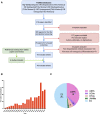Ubiquitin modification in osteogenic differentiation and bone formation: From mechanisms to clinical significance
- PMID: 36340031
- PMCID: PMC9634082
- DOI: 10.3389/fcell.2022.1033223
Ubiquitin modification in osteogenic differentiation and bone formation: From mechanisms to clinical significance
Abstract
The ubiquitin-proteasome system is an important pathway for mediating posttranslational modification and protein homeostasis and exerts a wide range of functions in diverse biological processes, including stem cell differentiation, DNA repair, and cell cycle regulation. Many studies have shown that ubiquitination modification plays a critical role in regulating the osteogenic differentiation of stem cells and bone formation through various mechanisms. This review summarizes current progress on the effects and mechanisms of ubiquitin modification on transcription factors and signaling pathways involved in osteogenic differentiation. Moreover, the review highlights the latest advances in the clinical application of drugs in bone tissue engineering. A thorough understanding of ubiquitin modifications may provide promising therapeutic targets for stem cell-based bone tissue engineering.
Keywords: epigenetics; mesenchymal stem cells; osteogenic differentiation; protein deubiquitinases; ubiquitin modification.
Copyright © 2022 Pan, Tang, Gu and Ge.
Conflict of interest statement
The authors declare that the research was conducted in the absence of any commercial or financial relationships that could be construed as a potential conflict of interest.
Figures


Similar articles
-
E3 ubiquitin ligases: key regulators of osteogenesis and potential therapeutic targets for bone disorders.Front Cell Dev Biol. 2024 Aug 15;12:1447093. doi: 10.3389/fcell.2024.1447093. eCollection 2024. Front Cell Dev Biol. 2024. PMID: 39211390 Free PMC article. Review.
-
Bone Tissue Engineering Using Osteogenic Cells: From the Bench to the Clinical Application.Tissue Eng Part C Methods. 2022 May;28(5):179-192. doi: 10.1089/ten.TEC.2022.0021. Tissue Eng Part C Methods. 2022. PMID: 35166162 Review.
-
Comprehensive analysis of lncRNA-miRNA-mRNA networks during osteogenic differentiation of bone marrow mesenchymal stem cells.BMC Genomics. 2022 Jun 7;23(1):425. doi: 10.1186/s12864-022-08646-x. BMC Genomics. 2022. PMID: 35672672 Free PMC article.
-
TRIM21 inhibits the osteogenic differentiation of mesenchymal stem cells by facilitating K48 ubiquitination-mediated degradation of Akt.Exp Cell Res. 2022 Mar 15;412(2):113034. doi: 10.1016/j.yexcr.2022.113034. Epub 2022 Jan 17. Exp Cell Res. 2022. PMID: 35051432
-
The E3 ligase RNF185 negatively regulates osteogenic differentiation by targeting Dvl2 for degradation.Biochem Biophys Res Commun. 2014 May 9;447(3):431-6. doi: 10.1016/j.bbrc.2014.04.005. Epub 2014 Apr 13. Biochem Biophys Res Commun. 2014. PMID: 24727453
Cited by
-
The role of WWP1 and WWP2 in bone/cartilage development and diseases.Mol Cell Biochem. 2024 Nov;479(11):2907-2919. doi: 10.1007/s11010-023-04917-7. Epub 2024 Jan 22. Mol Cell Biochem. 2024. PMID: 38252355 Review.
-
The promotive role of USP1 inhibition in coordinating osteogenic differentiation and fracture healing during nonunion.J Orthop Surg Res. 2023 Mar 2;18(1):152. doi: 10.1186/s13018-023-03594-y. J Orthop Surg Res. 2023. PMID: 36859264 Free PMC article.
References
Publication types
LinkOut - more resources
Full Text Sources

